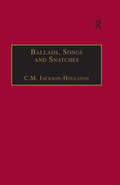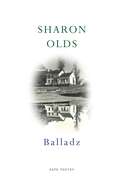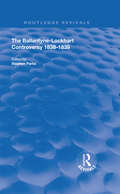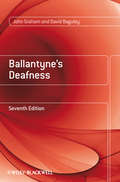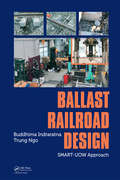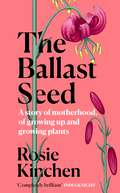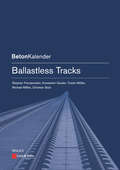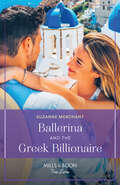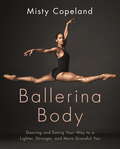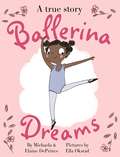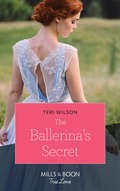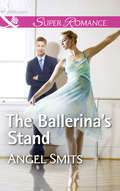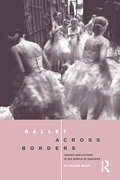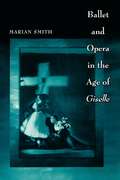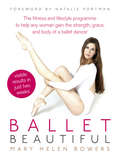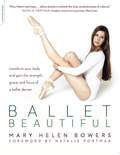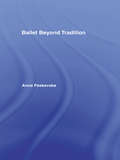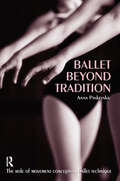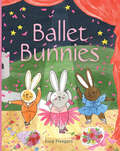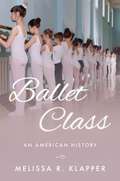- Table View
- List View
Ballads, Songs and Snatches: The Appropriation of Folk Song and Popular Culture in British 19th-Century Realist Prose (The Nineteenth Century Series)
by C.M. Jackson-HoulstonAs a book on allusion, this has interest for both the traditional literary or cultural historian and for the modern student of textuality and readership positions. It focuses on allusion to folksong, and, more tangentially, to popular culture, areas which have so far been slighted by literary critics. In the nineteenth century many authors attempted to mediate the culture(s) of the working classes for the enjoyment of their predominantly middle-class audiences. In so doing they took songs out of their original social and musical contexts and employed a variety of strategies which - consciously or unconsciously - romanticised, falsified or denigrated what the novels or stories claimed to represent. In addition, some writers who were well-informed about the cultures they described used allusion to song as a covert system of reference to topics such as sexuality and the criticism of class and gender relations which it was difficult to discuss directly.
Ballads, Songs and Snatches: The Appropriation of Folk Song and Popular Culture in British 19th-Century Realist Prose (The Nineteenth Century Series)
by C.M. Jackson-HoulstonAs a book on allusion, this has interest for both the traditional literary or cultural historian and for the modern student of textuality and readership positions. It focuses on allusion to folksong, and, more tangentially, to popular culture, areas which have so far been slighted by literary critics. In the nineteenth century many authors attempted to mediate the culture(s) of the working classes for the enjoyment of their predominantly middle-class audiences. In so doing they took songs out of their original social and musical contexts and employed a variety of strategies which - consciously or unconsciously - romanticised, falsified or denigrated what the novels or stories claimed to represent. In addition, some writers who were well-informed about the cultures they described used allusion to song as a covert system of reference to topics such as sexuality and the criticism of class and gender relations which it was difficult to discuss directly.
Balladz: ‘The most accessible poet of her generation’ Telegraph
by Sharon OldsArguably America's greatest living poet, Sharon Olds enters her eightieth year with a book for our times: a book of fear, fragility and love of life'At the time of have-not, I look at myself in this mirror,' writes Olds in this self-scouring, exhilarating collection, which opens with a section of quarantine poems, followed by her 'Amherst Balladz', honouring Emily Dickinson - 'she was our Girl - our Woman - / Man enough - for me' - and leads to celebrations of lost friends and lovers: her childhood, young womanhood, and old age all mixed up together. She examines her white privilege, sees her mother 'flushed and exalted at punishment time', celebrates the human body, even in ageing, and looks with wonder at the natural world and how we've spoiled it.Renowned for her poetry of searing honesty, sexual frankness and brave originality, Sharon Olds' new book emerges 'at the eleventh hour of the end of the world', from the time of plague, this time of loss, where she can look at the world and her life and tell us plainly 'love is the love of who we are, it is a form of knowing.'
The Ballantyne-Lockhart Controversy: 1838-1839 (Routledge Revivals)
by James Ballantyne J. G. LockhartOriginally published in 1974, The Ballantyne-Lockhart Controversy is reprint of three tracts concerning the Ballantyne - Lockhard controversy. Lockhart was the son-in-law of Sir Walter Scott and he made the claim that the Ballantynes played a key role in the financial ruin of Scott. The Ballantynes denied the charges. This book reveals much of interest on publishing and authors during the period.
Ballantyne's Deafness
by John Graham David BaguleyThis book is well established as the classic reference for professionals requiring up to date information on hearing and deafness. It is designed to serve as an introduction and as an inspiration to those entering the field to develop their expertise and insight. This Seventh Edition of Ballantyne’s Deafness has been substantially revised and updated to reflect significant developments in the field. In addition, brand new chapters and/or sections have been added on auditory processing, pharmacology, balance, hearing therapy and functional imaging.
Ballast Railroad Design: Smart-uow Approach
by Buddhima Indraratna Trung NgoThe rail network plays an essential role in transport infrastructure worldwide. A ballasted track is commonly used for several reasons, including economic considerations, load bearing capacity, rapid drainage and ease of maintenance. Given the ever-increasing demand for trains to carry heavier axle loads at greater speeds, traditional design and construction must undergo inevitable changes for sustainable performance. Ballast is an unbounded granular assembly that displaces when subjected to repeated train loading affecting track stability. During heavy haul operations, ballast progressively deteriorates and the infiltration of fluidized fines (mud pumping) from the underlying substructure and subgrade decreases its shear strength and also impedes drainage, while increasing track deformation and associated maintenance. Features: serves as a useful guide to assist the practitioner in new track design as well as remediating existing tracks. research discussed in this book has made considerable impact on the railway industry. resulting from collaborative research between academia and industry, incorporating sophisticated laboratory tests, computational modelling and field studies. This book presents a comprehensive procedure for the design of ballasted tracks based on a rational approach that combines extensive laboratory testing, computational modelling and field measurements conducted over the past two decades. Ballast Railroad Design: SMART-UOW Approach will not only become an imperative design aid for rail practitioners, but will also be a valuable resource for postgraduate students and researchers alike in railway engineering.
Ballast Railroad Design: SMART-UOW Approach
by Buddhima Indraratna Trung NgoThe rail network plays an essential role in transport infrastructure worldwide. A ballasted track is commonly used for several reasons, including economic considerations, load bearing capacity, rapid drainage and ease of maintenance. Given the ever-increasing demand for trains to carry heavier axle loads at greater speeds, traditional design and construction must undergo inevitable changes for sustainable performance. Ballast is an unbounded granular assembly that displaces when subjected to repeated train loading affecting track stability. During heavy haul operations, ballast progressively deteriorates and the infiltration of fluidized fines (mud pumping) from the underlying substructure and subgrade decreases its shear strength and also impedes drainage, while increasing track deformation and associated maintenance. Features: serves as a useful guide to assist the practitioner in new track design as well as remediating existing tracks. research discussed in this book has made considerable impact on the railway industry. resulting from collaborative research between academia and industry, incorporating sophisticated laboratory tests, computational modelling and field studies. This book presents a comprehensive procedure for the design of ballasted tracks based on a rational approach that combines extensive laboratory testing, computational modelling and field measurements conducted over the past two decades. Ballast Railroad Design: SMART-UOW Approach will not only become an imperative design aid for rail practitioners, but will also be a valuable resource for postgraduate students and researchers alike in railway engineering.
The Ballast Seed: A story of motherhood, of growing up and growing plants
by Rosie Kinchen'I loved The Ballast Seed. I couldn't put it down. Beautiful and sad and hopeful all at once - luminous and lush, full of dirt, darkness, sun light and soft new growth. It's a story of vulnerability, persistence and the will to live. This is a memoir that will make you weep, then roll up your sleeves and plant the seeds of a new life.' Cal Flyn author of Islands of AbandonmentThe surprise of a second pregnancy, so soon after the birth of her first son, plunged Rosie into a despair that spiralled into deep depression. Terrified at the prospect of adding another child into her already precariously balanced life, Rosie was compelled to find a new way of living. She found herself instinctively drawn to the local parks and scraps of communal green spaces in her local south east London neighbourhood, and to therapy via tending a hidden garden deep within the city. Interlaced with her responses to the travel journals of an eccentric 19th century female botanist and adventurer, Rosie elegantly describes how these pockets of nature amidst the urban sprawl provided just enough to mend her broken spirit.
Ballastless Tracks (Beton-Kalender Series)
by Stephan Freudenstein Konstantin Geisler Tristan Molter Michael Missler Christian StolzDue to increasing traffic flows the extension of transport infrastructure with rail roads and high speed lines is an ongoing process worldwide. Ballastless track systems with concrete slabs are used more and more. Following the first trials in the 1970s and more than four decades of R&D work on ballastless track, the level of development is such that it can be confirmed that ballastless track is suitable for use as an alternative to ballasted track. This book makes a contribution to the state of the art of ballastless track by describing the basics for designing the ballastless track. Important advice is provided regarding the construction of ballastless track on earthworks and in tunnels. There is also a description of the technical history of the development of ballastless track on bridges and the ensuing findings for bridge design. The state of the art of ballastless track for switches, important information on details concerning drainage, transitions, accessibility for road vehicles and experience gleaned from maintenance round off the work. Selected chapters from the German concrete yearbook are now being published in the new English "Beton-Kalender Series" for the benefit of an international audience. Since it was founded in 1906, the Ernst & Sohn "Beton-Kalender" has been supporting developments in reinforced and prestressed concrete. The aim was to publish a yearbook to reflect progress in "ferro-concrete" structures until - as the book's first editor, Fritz von Emperger (1862-1942), expressed it - the "tempestuous development" in this form of construction came to an end. However, the "Beton-Kalender" quickly became the chosen work of reference for civil and structural engineers, and apart from the years 1945-1950 has been published annually ever since.
Ballastless Tracks (Beton-Kalender Series)
by Stephan Freudenstein Konstantin Geisler Tristan Molter Michael Missler Christian StolzDue to increasing traffic flows the extension of transport infrastructure with rail roads and high speed lines is an ongoing process worldwide. Ballastless track systems with concrete slabs are used more and more. Following the first trials in the 1970s and more than four decades of R&D work on ballastless track, the level of development is such that it can be confirmed that ballastless track is suitable for use as an alternative to ballasted track. This book makes a contribution to the state of the art of ballastless track by describing the basics for designing the ballastless track. Important advice is provided regarding the construction of ballastless track on earthworks and in tunnels. There is also a description of the technical history of the development of ballastless track on bridges and the ensuing findings for bridge design. The state of the art of ballastless track for switches, important information on details concerning drainage, transitions, accessibility for road vehicles and experience gleaned from maintenance round off the work. Selected chapters from the German concrete yearbook are now being published in the new English "Beton-Kalender Series" for the benefit of an international audience. Since it was founded in 1906, the Ernst & Sohn "Beton-Kalender" has been supporting developments in reinforced and prestressed concrete. The aim was to publish a yearbook to reflect progress in "ferro-concrete" structures until - as the book's first editor, Fritz von Emperger (1862-1942), expressed it - the "tempestuous development" in this form of construction came to an end. However, the "Beton-Kalender" quickly became the chosen work of reference for civil and structural engineers, and apart from the years 1945-1950 has been published annually ever since.
Ballerina And The Greek Billionaire (Mills & Boon True Love)
by Suzanne MerchantKindred spirits…in paradise!
Ballerina Body: Dancing and Eating Your Way to a Lighter, Stronger, and More Graceful You
by Misty CopelandIn her first health and fitness book, celebrated ballerina Misty Copeland shows you how to find the motivation to get healthier and stronger, and how to refine the body you were born with to be lean, strong and flexible, with step-by-step advice, meal plans, workout routines and words of inspiration.Misty offers her own time-tested, ballet-inspired movements that are perfect for women who want to lengthen and strengthen, but don't want to run a marathon or lift weights. She also demonstrates the floor exercises that helped maintain her own ballerina body while recovering from an injury.Misty's eating plan focuses on vegetables, fruits, plant fats, animal proteins and beneficial oils - all of which keep her energetic and in top shape. With simple and delicious recipes for Granola, Spinach and Goat Cheese Salad, Quick Salsa Chili, and even a Ballerina Smoothie, you'll be satisfied and happy while getting leaner.To keep you motivated, Misty gives tips and words of encouragement on persevering even when you may want to give up, including a peek into her personal journal, to inspire you and help you stay on the road to your own ballerina body.
Ballerina Dreams: From Orphan To Dancer (Step Into Reading: Step 4 Ser.)
by Michaela DePrinceOne windy day, a magazine blew down the road. I reached out and caught it. A pretty picture of a woman was on the front cover of the magazine. She wore a short pink dress that stuck out around her in a circle. She looked very happy.At the age of three, Michaela DePrince found a photo of a ballerina that changed her life. She was living in an orphanage in Sierra Leone at the time, but was soon adopted by a family and brought to America. Michaela never forgot the photo of the dancer she once saw, and decided to make her dream of becoming a ballerina come true. She has been dancing ever since, and after a spell as a principal dancer in New York, now dances for the Dutch National Ballet in Amsterdam.Beautifully and gently illustrated by Ella Okstad, Ballerina Dreams is the younger-reader edition of Michaela DePrince's highly moving memoir, Hope in a Ballet Shoe.
The Ballerina's Stand: Because Of A Girl The Promise He Made Her Return To Marker Ranch The Ballerina's Stand (A Chair at the Hawkins Table #4)
by Angel SmitsLove reaches far beyond words
Ballet across Borders: Career and Culture in the World of Dancers
by Helena WulffThis absorbing book is ballet's 'biography' -- a revealing examination of a closed world, its competition and camaraderie, sexual politics, intimacies, pressures and, not least of all, its magic. Ballet companies have endeavoured to hide what is going on backstage lest the reality of highly strung nerves, constant fatigue and pain from injuries tarnish the illusion of ethereal figures and seemingly weightless steps in polished performances. But the audience's perceptions of fairy-tale worlds onstage are far removed from the experiences of the dancers themselves. The author, who trained to be a dancer, has been given an entrée to this private world that few outsiders ever see. Books on ballet tend to focus on performance. In contrast, this book, which draws on extensive fieldwork with major companies such as London's Royal Ballet, the American Ballet Theatre in New York, the Royal Swedish Ballet and the Ballett Frankfurt, is about dancers - how their careers are made and unmade and what happens in dance companies offstage. Anyone interested in the culture of ballet or the theatre, as well as students of anthropology, dance, performance and cultural studies, will want to read what really goes on when the curtain comes down.
Ballet across Borders: Career and Culture in the World of Dancers
by Helena WulffThis absorbing book is ballet's 'biography' -- a revealing examination of a closed world, its competition and camaraderie, sexual politics, intimacies, pressures and, not least of all, its magic. Ballet companies have endeavoured to hide what is going on backstage lest the reality of highly strung nerves, constant fatigue and pain from injuries tarnish the illusion of ethereal figures and seemingly weightless steps in polished performances. But the audience's perceptions of fairy-tale worlds onstage are far removed from the experiences of the dancers themselves. The author, who trained to be a dancer, has been given an entrée to this private world that few outsiders ever see. Books on ballet tend to focus on performance. In contrast, this book, which draws on extensive fieldwork with major companies such as London's Royal Ballet, the American Ballet Theatre in New York, the Royal Swedish Ballet and the Ballett Frankfurt, is about dancers - how their careers are made and unmade and what happens in dance companies offstage. Anyone interested in the culture of ballet or the theatre, as well as students of anthropology, dance, performance and cultural studies, will want to read what really goes on when the curtain comes down.
Ballet and Opera in the Age of "Giselle" (PDF)
by Marian SmithMarian Smith recaptures a rich period in French musical theater when ballet and opera were intimately connected. Focusing on the age of Giselle at the Paris Opéra (from the 1830s through the 1840s), Smith offers an unprecedented look at the structural and thematic relationship between the two genres. She argues that a deeper understanding of both ballet and opera--and of nineteenth-century theater-going culture in general--may be gained by examining them within the same framework instead of following the usual practice of telling their histories separately. This handsomely illustrated book ultimately provides a new portrait of the Opéra during a period long celebrated for its box-office successes in both genres. Smith begins by showing how gestures were encoded in the musical language that composers used in ballet and in opera. She moves on to a wide range of topics, including the relationship between the gestures of the singers and the movements of the dancers, and the distinction between dance that represents dancing (entertainment staged within the story of the opera) and dance that represents action. Smith maintains that ballet-pantomime and opera continued to rely on each other well into the nineteenth century, even as they thrived independently. The "divorce" between the two arts occurred little by little, and may be traced through unlikely sources: controversies in the press about the changing nature of ballet-pantomime music, shifting ideas about originality, complaints about the ridiculousness of pantomime, and a little-known rehearsal score for Giselle. ?
Ballet Beautiful: Transform Your Body And Gain The Strength, Grace, And Focus Of A Ballet Dancer
by Mary Helen BowersGet the strong, toned and graceful figure of a dancer – without the rigorous training! Mary Helen Bowers has helped tone and sculpt the bodies of a whole host of celebrities, including Natalie Portman for her role in Black Swan, plus Liv Tyler, Zooey Deschanel and Helena Christensen. Now, in this fantastic fitness guide, she reveals her exercise, diet and lifestyle plan for transforming your whole body. - Achieve the long, toned and powerful body shape of a dancer - Target trouble areas, such as legs, bum and tummy - Get a dancer's beautiful posture and elegance - Lose weight and turn fat into muscle - Radically transform your physique - Noticeable results in just 14 days
Ballet Beautiful: Transform Your Body and Gain the Strength, Grace, and Focus of a Ballet Dancer
by Mary Helen BowersBallet-inspired fitness for every woman! You don't have to be a professional ballerina to look like one! With Mary Helen Bowers&’ Ballet Beautiful, forget beating yourself up in the gym and suffering through starvation diets for some unattainable goal. You can achieve your ideal body and develop the strength, grace, and elegance of a dancer by following Mary Helen&’s proven program—one that&’s got everyone from celebrities to busy moms to executives raving! Ballet Beautiful is a fitness method that blends the artistry and athleticism of ballet with an easy, accessible eating plan that works for every body – and absolutely no dance experience is required. Created by professional ballerina Mary Helen Bowers, this transformative approach to fitness and health will reshape your body and your mind! Ballet Beautiful&’s three-fold approach is not an extreme workout nor is it a radical diet for an overnight fix; it's a roadmap to achieving and maintaining your ideal health, shape and size—all with the elegance and strength of a ballerina. Part One of the book introduces the program's empowering mindset, the key to supporting and guiding you through lasting change. Part Two, the Ballet Beautiful Method, consists of challenging, effective, and fun workouts that sculpt and tone sleek ballet muscles and build beautiful posture. Whether you have a full hour or only 15 minutes, you can tailor the program to your own schedule and needs. Part Three shares the Ballet Beautiful Lifestyle, a healthy, balanced approach to nutrition. With meal plans, shopping tips and quick but delicious daily recipes that will satisfy and nourish your entire body, it&’s a stress-free, diet-free plan that will help keep you feeling as strong and healthy as you look.
Ballet Beyond Tradition
by Anna PaskevskaFor nearly a century, the training of ballet and modern dancers has followed two divergent paths. Modern practitioners felt ballet was artificial and injurious to the body; ballet teachers felt that modern dancers lacked the rigorous discipline and control that comes only from years of progressive training. Ballet Beyond Tradition seeks to reconcile these age-old conflicts and bring a new awareness to ballet teachers of the importance of a holistic training regimen that draws on the best that modern dance and movement-studies offers.
Ballet Beyond Tradition
by Anna PaskevskaFor nearly a century, the training of ballet and modern dancers has followed two divergent paths. Modern practitioners felt ballet was artificial and injurious to the body; ballet teachers felt that modern dancers lacked the rigorous discipline and control that comes only from years of progressive training. Ballet Beyond Tradition seeks to reconcile these age-old conflicts and bring a new awareness to ballet teachers of the importance of a holistic training regimen that draws on the best that modern dance and movement-studies offers.
Ballet Bunnies
by Lucy FreegardA gorgeous glittery book with a charming tale about bravery and conquering ones fears
Ballet Class: An American History
by Melissa R. KlapperSurveying the state of American ballet in a 1913 issue of McClure's Magazine, author Willa Cather reported that few girls expressed any interest in taking ballet class and that those who did were hard-pressed to find anything other than dingy studios and imperious teachers. One hundred years later, ballet is everywhere. There are ballet companies large and small across the United States; ballet is commonly featured in film, television, literature, and on social media; professional ballet dancers are spokespeople for all kinds of products; nail polish companies market colors like "Ballet Slippers" and "Prima Ballerina;" and, most importantly, millions of American children have taken ballet class. Beginning with the arrival of Russian dancers like Anna Pavlova, who first toured the United States on the eve of World War I, Ballet Class: An American History explores the growth of ballet from an ancillary part of nineteenth-century musical theater, opera, and vaudeville to the quintessential extracurricular activity it is today, pursued by countless children nationwide and an integral part of twentieth-century American childhood across borders of gender, class, race, and sexuality. A social history, Ballet Class takes a new approach to the very popular subject of ballet and helps ground an art form often perceived to be elite in the experiences of regular, everyday people who spent time in barre-lined studios across the United States. Drawing on a wide variety of materials, including children's books, memoirs by professional dancers and choreographers, pedagogy manuals, and dance periodicals, in addition to archival collections and oral histories, this pathbreaking study provides a deeply-researched national perspective on the history and significance of recreational ballet class in the United States and its influence on many facets of children's lives, including gender norms, consumerism, body image, children's literature, extracurricular activities, and popular culture.
Ballet Class: An American History
by Melissa R. KlapperSurveying the state of American ballet in a 1913 issue of McClure's Magazine, author Willa Cather reported that few girls expressed any interest in taking ballet class and that those who did were hard-pressed to find anything other than dingy studios and imperious teachers. One hundred years later, ballet is everywhere. There are ballet companies large and small across the United States; ballet is commonly featured in film, television, literature, and on social media; professional ballet dancers are spokespeople for all kinds of products; nail polish companies market colors like "Ballet Slippers" and "Prima Ballerina;" and, most importantly, millions of American children have taken ballet class. Beginning with the arrival of Russian dancers like Anna Pavlova, who first toured the United States on the eve of World War I, Ballet Class: An American History explores the growth of ballet from an ancillary part of nineteenth-century musical theater, opera, and vaudeville to the quintessential extracurricular activity it is today, pursued by countless children nationwide and an integral part of twentieth-century American childhood across borders of gender, class, race, and sexuality. A social history, Ballet Class takes a new approach to the very popular subject of ballet and helps ground an art form often perceived to be elite in the experiences of regular, everyday people who spent time in barre-lined studios across the United States. Drawing on a wide variety of materials, including children's books, memoirs by professional dancers and choreographers, pedagogy manuals, and dance periodicals, in addition to archival collections and oral histories, this pathbreaking study provides a deeply-researched national perspective on the history and significance of recreational ballet class in the United States and its influence on many facets of children's lives, including gender norms, consumerism, body image, children's literature, extracurricular activities, and popular culture.
